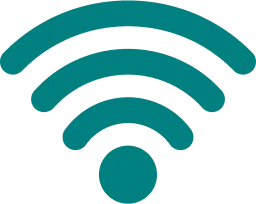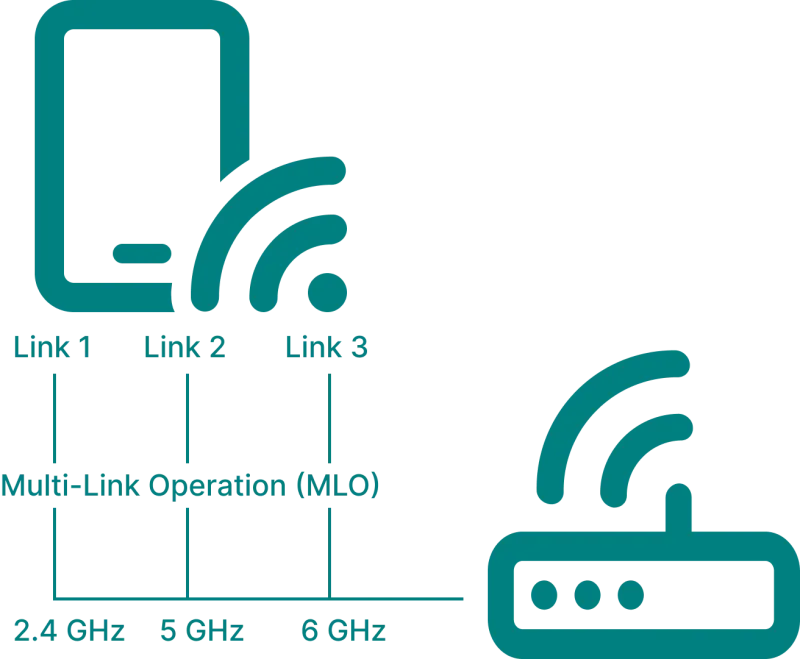
Wi-Fi 7: The Next Generation
The innovative 802.11be standard, also known as Wi-Fi 7, offers higher data throughput, better transmission and lower latency, which represents a significant advance for consumers and businesses.Wi-Fi Technology
Wi-Fi 7: The new Standard 802.11be
Get ready for the latest evolution in wireless connectivity: Wi-Fi 7 is here, offering impressive speeds, minimal latency and consistent reliability. This innovation, announced by the Wi-Fi Alliance in January 2024, promises to revolutionize our connectivity experiences whether we are at home, in the office or on the move. While Wi-Fi 6/6E have already made great strides, Wi-Fi 7 will push the boundaries even further.
The new standard, Wi-Fi 7, is primarily aimed at improving:
Data throughput
Transmission performance
Stability as well as latency
Wi-Fi 7 builds on the foundations already laid with Wi-Fi 6E. These improvements promise benefits for both private users and companies that rely on fast data traffic in their internal networks.
In the following chart, you can see the development of Wi-Fi over the past years until today.
Wi-Fi: Data Transfer Rate from 1997 to 2024
Evolution of Wi-Fi data rates up to today's maximum of 46 Gbps.
Wi-Fi: Data Transfer Rate from 1997 to 2024
Evolution of Wi-Fi data rates up to today's maximum of 46 Gbps.

Updates
From Wi-Fi 6 to Wi-Fi 7
Unlike Wi-Fi 6, Wi-Fi 7, which has the official technical name IEEE 802.11be with the addition "Extremely High Throughput (EHT)", does not introduce a new frequency band. Wi-Fi 7 still transmits via 2.4 GHz, 5 GHz and the 6 GHz band introduced with Wi-Fi 6. However, the maximum signal width under Wi-Fi 7 has been increased to 320 MHz, while the limit under Wi-Fi 6 is 160 MHz.
This change means that data rates of around 46 Gbit/s are now possible, which is more than four times the maximum 9.6 Gbit/s of Wi-Fi 6. It should be noted that these are laboratory values that are achieved under theoretical, best possible conditions. In practice, lower speeds are likely to be expected due to numerous interferences in real building complexes.
Wi-Fi 7 Key Features
Bandwidth
Signal width is doubled from 160 MHz to 320 MHz channels
4K QAM Modulation
Increase in the modulation rate from 1024-QAM to 4096-QAM
Multi-link Operation (MLO)
Simultaneous reception of several data packets from different sources
How is the higher Data Rate achieved?
The increased data rate of up to 46 Gbit/s in Wi-Fi 7 is achieved by several factors:
Firstly, the signal width is doubled from 160 MHz to 320 MHz.
The Multi-link Operation (MLO) enables the simultaneous reception of several data packets from different sources, which further increases efficiency.
An additional increase in the modulation rate from 1024-QAM (Quadrature Amplitude Modulation) to 4096-QAM contributes around 20 % to the increase in data throughput.
The combination of all these improvements and the doubling of the number of antennas results in the significantly higher data throughput of the new WLAN standard.

Improvement for Security and Latency
Multi-link operation (MLO) enables devices in a Wi-Fi 7-compatible network to connect to multiple target systems simultaneously via multiple frequency bands. This enables faster data transmission while significantly reducing latency. This feature is particularly useful in environments where low latency is critical - basically any application that requires near real-time input and output.
The use of wider frequency bands represents an additional hurdle for potential attackers attempting to intercept and decrypt data traffic. Thanks to WPA3 encryption, the transmitted data is practically impossible to read or exploit under real conditions. This security measure is particularly important in corporate networks where highly sensitive data is transmitted.
Technical Innovations
From Wi-Fi 5 to Wi-Fi 7
Wi-Fi 5
| Frequency band | 5 GHz |
|---|---|
| Standard | 802.11ac |
| Max. data rate | 1.3 Gbit/s |
| Access technology | OFDM |
| Antennas | 4 x 4 MU-MIMO |
| Modulation | 256-QAM |
| Target Wake Time (TWT) | No |
| BSS Coloring | No |
| WPA3 | No |
Wi-Fi 6
| Frequency band | 2.4 GHz, 5 GHz |
|---|---|
| Standard | 802.11ax |
| Max. data rate | 9.6 Gbit/s |
| Access technology | OFDMA |
| Antennas | 8 x 8 MU-MIMO |
| Modulation | 1024-QAM |
| Target Wake Time (TWT) | Yes |
| BSS Coloring | Yes |
| WPA3 | Yes |
Wi-Fi 6E
| Frequency band | 2.4 GHz, 5 GHz, 6 GHz |
|---|---|
| Standard | 802.11ax |
| Max. data rate | 9.6 Gbit/s |
| Access technology | OFDMA |
| Antennas | 8 x 8 MU-MIMO |
| Modulation | 1024-QAM |
| Target Wake Time (TWT) | Yes |
| BSS Coloring | Yes |
| WPA3 | Yes |
Wi-Fi 7
| Frequency band | 2.4 GHz, 5 GHz, 6 GHz |
|---|---|
| Standard | 802.11be |
| Max. data rate | 46 Gbit/s |
| Access technology | OFDMA, MLO |
| Antennas |
8 x 8 MU-MIMO, 16 x 16 MU-MIMO |
| Modulation | 4096-QAM |
| Target Wake Time (TWT) | Yes |
| BSS Coloring | Yes |
| WPA3 | Yes |
| Parameter | Wi-Fi 5 | Wi-Fi 6 | Wi-Fi 6E | Wi-Fi 7 |
|---|---|---|---|---|
| Frequency band | 5 GHz | 2.4 GHz, 5 GHz | 2.4 GHz, 5 GHz, 6 GHz |
2.4 GHz, 5 GHz, 6 GHz |
| Standard | 802.11ac | 802.11ax | 802.11ax | 802.11be |
| Max. data rate | 1.3 Gbit/s | 9.6 Gbit/s | 9.6 Gbit/s | 46 Gbit/s |
| Access technology | OFDM | OFDMA | OFDMA | OFDMA, MLO |
| Antennas | 4 x 4 MU-MIMO | 8 x 8 MU-MIMO | 8 x 8 MU-MIMO |
8 x 8 MU-MIMO, 16 x 16 MU-MIMO |
| Modulation | 256-QAM | 1024-QAM | 1024-QAM | 4096-QAM |
| Target Wake Time (TWT) | No | Yes | Yes | Yes |
| BSS Coloring | No | Yes | Yes | Yes |
| WPA3 | No | Yes | Yes | Yes |
Wi-Fi 7: Bandwidth and Channel Allocation
Wi-Fi 7: Bandwidth and Channel Allocation
Practical Advantages of Switching to Wi-Fi 7
The theoretical advantages of the new Wi-Fi standard manifest themselves in practice in a variety of ways and offer solutions for different application scenarios:
By introducing the 6.0 GHz frequency band compared to Wi-Fi 5, environments with high utilization benefit in particular. If the 2.4 GHz and 5.0 GHz frequency bands are overused, Wi-Fi 7 offers an alternative solution with a new frequency band. This reduces interference and improves transmission speed and signal quality. The new standard can provide considerable relief, particularly in public Wi-Fi networks, densely populated building complexes and companies with many employees.
The high data rate opens up new areas of application, including video streaming in resolutions from 4K to 8K, augmented and virtual reality applications, latency-critical cloud gaming platforms and similar areas of use. Industry and remote applications in areas such as medicine and diagnostics also benefit from this development.
Multi-link operation is particularly beneficial in environments where a large number of end devices are connected to one or a few access points. The simultaneous supply of several devices reduces the utilization of a frequency band, which in turn significantly reduces latency. Typical areas of application are large office complexes where only a few routers are available.
If you see a need for improvements in the areas of data rate, latency, security or signal quality, Wi-Fi 7 could provide an elegant and immediately available solution to these problems.
One Disadvantage: the Range using 6.0 GHz
As with Wi-Fi 6, it is important to note that although the 6.0 GHz frequency band offers additional capacity, higher frequencies generally mean a shorter range. To ensure maximum signal strength, access points and end devices should therefore not be placed too far apart.
In addition, walls and other obstacles can further impair signal quality. Before making a complete switch to Wi-Fi 7, it is therefore advisable to ideally carry out a test to determine whether the planned hardware configuration can function effectively under the existing conditions.
Which Devices Support Wi-Fi 7?
Routers and repeaters, smartphones, laptops, IoT devices, smart home tech - all need the appropriate hardware to fully benefit from the new Wi-Fi 7 features - but backwards compatibility is maintained.
Router and Repeater
Asus ROG Rapture GT-BE98
Netgear RS700S
TP-Link Archer BE800
Smartphones
Samsung Galaxy S24 Ultra
Xiaomi 13T Pro
Honor Magic5 Pro
Laptops
Dell XPS 13 Plus
HP Spectre x360 14
MSI Titan 18 HX A14V
This is just a small selection of the many devices that support Wi-Fi 7. Over time, more and more devices will be equipped with Wi-Fi 7 as all major chip manufacturers, including Broadcom, Qualcomm and Intel, offer chipsets that support Wi-Fi 7. (as of March/2024)
Ensure Compatibility with Wi-Fi 7
Like its predecessors, Wi-Fi 7 remains fully backwards compatible. This means that devices that only support Wi-Fi 5 or Wi-Fi 6E can communicate seamlessly with the latest routers and access points that support Wi-Fi 7. Data transfer between other Wi-Fi 7 devices is also no problem.
However, older devices will not be able to benefit from the new functions of the standard. For example, a notebook that only supports Wi-Fi 5 will still be limited to the maximum speed and latency of Wi-Fi 5 after connecting to a Wi-Fi 7 router.
Wi-Fi Device Testing with DFS
Dynamic Frequency Selection (DFS) test in our laboratory with the Rohde & Schwarz TS8997 wireless measurement system. DFS is critical for wireless networks in certain 5 GHz bands to avoid interference. Our demonstration shows how a primary Wi-Fi device detects radar signals, selects the channels and ensures seamless communication. Benefit from our know-how and modern laboratory equipment and contact us for more information.
WLAN Certification
Bring your Wi-Fi Product to Market with Us
To ensure that your WLAN products are up to standard and can provide a secure and reliable service, we perform our testing services in our accredited laboratory with state-of-the-art equipment. We offer the full scope of Wi-Fi testing and guarantee transparent and fast certification processes for market access.
Learn more about our WLAN testing and certification services.
CE (Europa)
Ready for the European Market
FCC (USA)
Handling the US Type Approval procedure
ISED (Canada)
Your way to the Canadian Market
MIC (Japan)
Get your Type Approval for Japan
Let's get in Touch
The experts at IB-Lenhardt AG and IBL-Lab GmbH are always there for you. Just contact us!Frequently Asked Questions
All you need to know about Wi-Fi 7
- What do the abbreviations mean?
-
OFDMA: Orthogonal Frequency-Division Multiple Access. Divides channels into small frequency allocations, enabling parallel transmission of small data packets, boosting network performance.
TWT: Target Wake Time. Allows access points to schedule device access times, reducing standby time, enhancing energy efficiency in Wi-Fi networks.
WPA3: Wi-Fi Protected Access Version 3. Latest Wi-Fi security standard, introduced in 2018, enhancing authentication procedures, particularly against dictionary attacks.
U-NII: U-NII (Unlicensed National Information Infrastructure) is a designation by the US Federal Communications Commission (FCC) for license-free radio frequency bands.
- In which areas does Wi-Fi 7 already offer concrete advantages?
-
Once the necessary hardware has been set up, you will benefit in particular in the areas of data transfer rate, latency and signal strength. In addition, there are further benefits in terms of security and privacy, as wider signals are more difficult for potential attackers to read.
- Which devices need to be updated to use Wi-Fi 7?
-
To take full advantage of the new standard, all devices involved - both access points and end devices - must support the new technology. Otherwise, the lowest standard will be used automatically. For example, when connecting a notebook with Wi-Fi 5 and a router with Wi-Fi 7, the older Wi-Fi 5 standard would be used, which can lead to limitations in terms of data rate and latency.
- What are the disadvantages of Wi-Fi 7?
-
Apart from the investment costs for new hardware, the new standard has no other disadvantages compared to Wi-Fi 6 or Wi-Fi 6E. However, when comparing it with Wi-Fi 5, the shorter range of the 6.0 GHz frequency band must be taken into account, which could possibly lead to challenges when installing the devices in some environments.
- When will the successor to Wi-Fi 8 be released?
-
Only discussions are currently underway, but concrete details are still pending. It is possible that an additional frequency band at 60 GHz will be released and consideration is being given to increasing the signal width up to 640 MHz. However, the short range at 60 GHz could be a potential obstacle that would only be useful under specific conditions. It will be some time before the specifications of Wi-Fi 8 are finalized. In the meantime, Wi-Fi 7 is an excellent choice.

Contact us
Unlock the Power of Wi-Fi 7 for Your Business
Wi-Fi 7-enabled products for end consumers must follow strict guidelines in order to carry the Wi-Fi 7 Certified label.
In our laboratory, we go through standardized certification processes for your hardware and do our part to ensure the smooth functioning of your WLAN devices. By contacting us at an early stage and obtaining the relevant certificates, you will secure a comprehensive competitive advantage over your competitors.